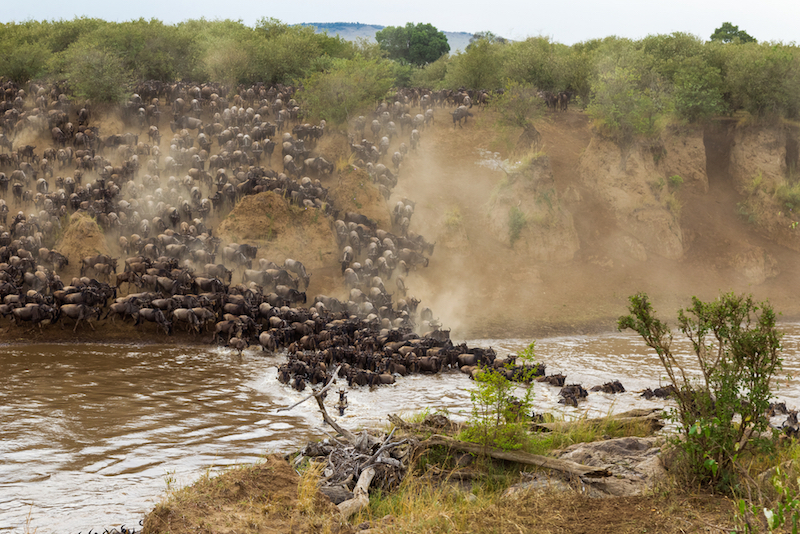Kenya's Maasai Mara: Facts About the Wildlife, Climate and Culture

In southwestern Kenya, in the Kenya Rift Valley Province, lies 583 square miles (1,510 square kilometers) of protected land known as the Maasai Mara National Reserve. It was established in 1961 and is a popular safari destination, renowned for its wildlife population, according to a 2019 study about the park published in the journal Land Use Policy. The wildlife roam freely across the boundaries of the reserve into areas with several villages, where animals and humans coexist.
Also known as Masai Mara, Maasai Mara or simply the Mara, the reserve lies at between 4,875 and 7,052 feet (1486 and 2149 meters) in elevation and extends south to Serengeti National Park. The name comes from the local Maasai people, who called this expanse of land "Mara," or spotted, in their native language of Maa, because of the way the acacia trees and wildlife dotted the plains.
Wildlife
A diverse group of animals call the Maasai Mara home, including Africa's "big five" (the African elephant, Cape buffalo, African leopard, African lion and African black rhino). Cheetahs, wildebeests, gazelles, zebras, hyenas, giraffes, crocodiles, hippos, more than 500 bird species and many more residents can also be found across the reserve. [In Photos: The Lions of Kenya's Masai Mara]
The most popular time to visit the reserve is between July and October. The peak of the wildebeest migration, usually in October, is a particularly popular time in the park, as visitors come to see the more than 2 million animals travel up to 500 miles (800 km) from Serengeti National Park in Tanzania to the Maasai Mara National Reserve, according to the World Wildlife Fund. During their migration, wildebeest and several hundred thousand other migratory mammals, including gazelles and zebras, must cross the Mara River while avoiding crocodiles and other predators, such as large cats and hyenas.
An estimated 250,000 wildebeest never make it to their destination, as they fall prey to carnivores, die of hunger, thirst or exhaustion, or drown in the Mara River, according to the World Wildlife Fund. The fallen animals, however, provide a wealth of food and nutrients for the ecosystem.
Climate
The great migration occurs during the main dry season, which lasts from June through October. The two wet seasons, a short one and a long one, occur between November and December and March and May, respectively. Due to Kenya's location at the equator, temperatures there remain fairly constant throughout the year, with daytime temperatures of about 73 degrees Fahrenheit (23 degrees Celsius) during the dry season and 81 F (27 C) during the wet season.
Average annual rainfall is about 1 meter (3 feet) per year, with nearly 80% of the rain falling during the wet season, according to a 2018 article published in the journal PLOS One. During the dry season, many of the temporary lakes and rivers dry up, leaving the one permanent body of water in the region, the Mara River, to provide for both the Maasai Mara and Serengeti regions.
Flooding is common during the wet season and can displace wildlife and increase the risk of diseases such as Rift Valley fever and anthrax, both of which can infect domesticated and wild animals as well as humans. The flooding also affects livestock and agriculture in the surrounding areas.
Culture
The Maasai people, known for their fierce warriors and bright red robes, were once one of the dominating native tribes in Kenya. They are one of the few who have retained much of their traditions and lifestyles, according to the Maasai Wilderness Conservation Trust.
The Maasai moved into the highlands of what is now Kenya in the early 17th century and spread across what became Kenya and south into what is now Tanzania soon after, according to an article from the nonprofit Cultural Survival. They were seminomadic, moving with their prized cattle herds to different areas during the wet and dry seasons to prevent any one area from becoming overgrazed.
As with most other African tribes, however, the Maasai lost much of their fertile lands and parts of their culture when European settlers moved into the territory. The Maasai people are no longer nomadic and are now settled in a single location, where they depend on local agriculture and tourism to sustain their lifestyle and traditions.
Within the Maasai Mara, conflicts between wildlife and villagers have become increasingly controversial. As humans and beasts compete for natural resources in this remote area, millions of animals have been forced to alter their behaviors, territories and migration patterns. As a result, their populations have suffered.
Additional resources:
- Learn about research in the Maasai Mara, from the Maasai Mara Science and Development Initiative.
- Read more about the conservation efforts within the Maasai Mara, from the Maasai Wilderness Conservation Trust.
- Discover more about the Maasai people, from the Maasai Association.
Sign up for the Live Science daily newsletter now
Get the world’s most fascinating discoveries delivered straight to your inbox.

Rachel Ross is a science writer and editor focusing on astronomy, Earth science, physical science and math. She holds a Bachelor of Arts in Philosophy from the University of California Davis and a Master's degree in astronomy from James Cook University. She also has a certificate in science writing from Stanford University. Prior to becoming a science writer, Rachel worked at the Las Cumbres Observatory in California, where she specialized in education and outreach, supplemented with science research and telescope operations. While studying for her undergraduate degree, Rachel also taught an introduction to astronomy lab and worked with a research astronomer.










